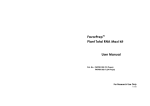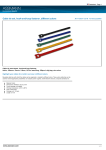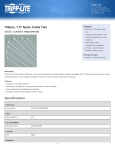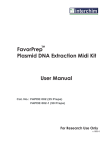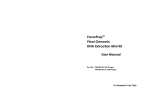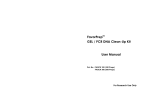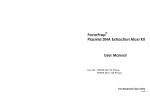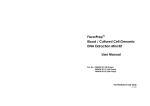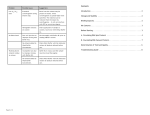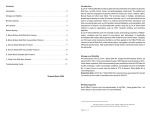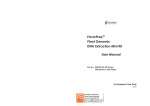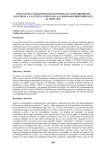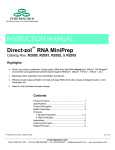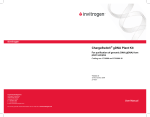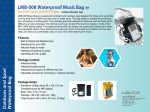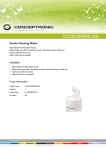Download FavorPrep Plant Total RNA Mini Kit User Manual
Transcript
FavorPrepTM Plant Total RNA Mini Kit User Manual Cat. No.: FAPRK 001 (50 Preps) FAPRK 001-1 (100 Preps) For Research Use Only Introduction Kit Contents FAPRK001 (50preps) Plant Total RNA Mini Kit is specially designed for purification of total RNA from a variety of plant tissues. The method uses detergents and a chaotropic FAPRK001-1 (100preps) FARB Buffer 30 ml 60 ml FAPRB Buffer 30 ml 60 ml and the contaminants are washed with an ethanol contained wash buffer. Wash Buffer 1 25 ml 60 ml Finally, the purified total RNA is eluted by RNase-free water. The protocol Wash Buffer 2 (conc.)* 15 ml 35 ml 6 ml 6 ml salt to lyse cell and inactivate RNase. In the presence of binding buffer with chaotropic salt, the total RNA in the lysate binds to glass fiber matrix in the spin column. The optional DNase treatments can remove DNA residues does not require phenol extraction and alcohol precipitation. The entire procedure can be completed in 60 minutes. The purified total RNA is ready RNase-free water for RT, RT-PCR, real-time PCR, Northern blotting. ssRNA and dsRNA of 200 bp Filter column 50pcs 100pcs FARB-Mini column 50pcs 100pcs 100pcs 200pcs to 1000's of bps in length are efficiently purified. 2ml collection tube Quality Control The quality of Plant Total RNA Mini Kit is tested on a lot-to-lot basis. * For FAPRK001, add 60 ml ethanol(96-100%) to Wash Buffer 2. * For FAPRK001-1, add 140 ml ethanol(96-100%) to Wash Buffer 2. The Kits are tested by isolation of total RNA from 25 mg young leaf. Purified RNA could be quantified with spectrophotometer and checked by agarose gel. Caution The component contains irritant agent. During operation, always Sample Amount: up to 100 mg plant tissue or wear a lab coat, disposable gloves, and protective goggles. 1 X 107 plant cells Format: spin column Operation time: < 60 min Yield: References up to 100 ìg Elution volume: 50 ìl (1) Vogelstein, B., and Gillespie, D. (1979) Proc. Natl. Acad. Sci. USA 76, 615. 1-FAPRK FAPRK-2 Introduction Kit Contents FAPRK001 (50preps) Plant Total RNA Mini Kit is specially designed for purification of total RNA from a variety of plant tissues. The method uses detergents and a chaotropic FAPRK001-1 (100preps) FARB Buffer 30 ml 60 ml FAPRB Buffer 30 ml 60 ml and the contaminants are washed with an ethanol contained wash buffer. Wash Buffer 1 25 ml 60 ml Finally, the purified total RNA is eluted by RNase-free water. The protocol Wash Buffer 2 (conc.)* 15 ml 35 ml 6 ml 6 ml salt to lyse cell and inactivate RNase. In the presence of binding buffer with chaotropic salt, the total RNA in the lysate binds to glass fiber matrix in the spin column. The optional DNase treatments can remove DNA residues does not require phenol extraction and alcohol precipitation. The entire procedure can be completed in 60 minutes. The purified total RNA is ready RNase-free water for RT, RT-PCR, real-time PCR, Northern blotting. ssRNA and dsRNA of 200 bp Filter column 50pcs 100pcs FARB-Mini column 50pcs 100pcs 100pcs 200pcs to 1000's of bps in length are efficiently purified. 2ml collection tube Quality Control The quality of Plant Total RNA Mini Kit is tested on a lot-to-lot basis. * For FAPRK001, add 60 ml ethanol(96-100%) to Wash Buffer 2. * For FAPRK001-1, add 140 ml ethanol(96-100%) to Wash Buffer 2. The Kits are tested by isolation of total RNA from 25 mg young leaf. Purified RNA could be quantified with spectrophotometer and checked by agarose gel. Caution The component contains irritant agent. During operation, always Sample Amount: up to 100 mg plant tissue or wear a lab coat, disposable gloves, and protective goggles. 1 X 107 plant cells Format: spin column Operation time: < 60 min Yield: References up to 100 ìg Elution volume: 50 ìl (1) Vogelstein, B., and Gillespie, D. (1979) Proc. Natl. Acad. Sci. USA 76, 615. 1-FAPRK FAPRK-2 Important notes Plant RNA Mini Extraction Protocol 1. Make sure everything is RNase-free when handling RNA. *Please Read Important Notes Before Starting The Following Steps. 2. Buffers provided in this system contain irritants. Wear gloves and lab coat when handling these buffers. 1. Grind up to 100 mg plant sample under liquid nitrogen to a fine powder and transfer to a new microcentrifuge tube (not provided) 3. Pipet a required volume of FARB Buffer or FAPRB Buffer to another RNase-free container and add 10 µl â-mercaptoethanol (â-ME) per 1 ml 2. Add 450 µl of FARB Buffer (â-ME added) to the sample powder and vortex vigorously. Use FAPRB Buffer (â-ME added) if plant FARB Buffer or FAPRB Buffer before use. sample contains sticky secondary metabolites such as maize with milky endosperm or mycelia of filamentous fungi. 4. Add 60 ml (FAPRK001)/140 ml (FAPRK001-1) ethanol (96~100%) to Wash Buffer 2 when first open. 3. Place a Filter Column into a Collection Tube. And transfer the mixture to Filter Column then centrifuge for 2 min. 5. All centrifuge steps are done at full speed (14,000 rpm or 10,000 xg) in a microcentrifuge. 4. Transfer the clarified supernatant from the Collection Tube to a new microcentrifuge tube (not provided) and adjust the 6. Dilute RNase-free DNase 1 in reaction buffer (1 M NaCl, 10 mM MnCl 2 20 mM volume of the clear lysate. Tris-HCl, pH 7.0 at 25oC) to final conc. = 0.5 U/µl. 5. Add 0.5 volume of ethanol (96 - 100%) to the clear lysate and mix by pietting. • For example, add 250 µl of ethanol to 500 µl of the clear lysate. 6. Place a FARB Mini Column into a Collection Tube. And transfer 750 µl of the ethanol added sample (including any precipitate) to FARB Mini Column. Centrifuge for 1 min and discard the flowthrough. 7. 3-FAPRK Repeat step 6 for rest of the sample. FAPRK-4 Important notes Plant RNA Mini Extraction Protocol 1. Make sure everything is RNase-free when handling RNA. *Please Read Important Notes Before Starting The Following Steps. 2. Buffers provided in this system contain irritants. Wear gloves and lab coat when handling these buffers. 1. Grind up to 100 mg plant sample under liquid nitrogen to a fine powder and transfer to a new microcentrifuge tube (not provided) 3. Pipet a required volume of FARB Buffer or FAPRB Buffer to another RNase-free container and add 10 µl â-mercaptoethanol (â-ME) per 1 ml 2. Add 450 µl of FARB Buffer (â-ME added) to the sample powder and vortex vigorously. Use FAPRB Buffer (â-ME added) if plant FARB Buffer or FAPRB Buffer before use. sample contains sticky secondary metabolites such as maize with milky endosperm or mycelia of filamentous fungi. 4. Add 60 ml (FAPRK001)/140 ml (FAPRK001-1) ethanol (96~100%) to Wash Buffer 2 when first open. 3. Place a Filter Column into a Collection Tube. And transfer the mixture to Filter Column then centrifuge for 2 min. 5. All centrifuge steps are done at full speed (14,000 rpm or 10,000 xg) in a microcentrifuge. 4. Transfer the clarified supernatant from the Collection Tube to a new microcentrifuge tube (not provided) and adjust the 6. Dilute RNase-free DNase 1 in reaction buffer (1 M NaCl, 10 mM MnCl 2 20 mM volume of the clear lysate. Tris-HCl, pH 7.0 at 25oC) to final conc. = 0.5 U/µl. 5. Add 0.5 volume of ethanol (96 - 100%) to the clear lysate and mix by pietting. • For example, add 250 µl of ethanol to 500 µl of the clear lysate. 6. Place a FARB Mini Column into a Collection Tube. And transfer 750 µl of the ethanol added sample (including any precipitate) to FARB Mini Column. Centrifuge for 1 min and discard the flowthrough. 7. 3-FAPRK Repeat step 6 for rest of the sample. FAPRK-4 Plant RNA Mini Extraction Protocol 8. (Optional): To eliminate genomic DNA contamination, follow the steps from 8a. Otherwise, proceed to step 9 directly. 13. Add 50 µl of RNase-free ddH2O to the membrane center of FARB Mini Column. Stand FARB Mini Column for 1 min. 8a. Add 250 µl of Wash Buffer 1 to wash FARB Mini Column. Centrifuge for 1 min then discard the flow-through. 8b. Add 100 µl of RNase-free DNase 1 solution (0.5 U/µl, not provided) 14. Centrifuge for 2 min to elute RNA. 15. Store RNA at -70oC. to the membrane center of FARB Mini Column. Place the Column on the benchtop for 15 min. 8c. Add 250 µl of Wash Buffer 1 to wash FARB Mini Column. Centrifuge for 1 min then discard the flow-through. Protocol Technical Specifications 8d. After DNase 1 treatment, proceed to step 10. Different plant species contain a lot of different metabolites like 9. Add 500 µl of Wash Buffer 1 to wash FARB Mini Column. Centrifuge for polysaccharides, polyphenolics, lipids or proteins. Therefore, we 1 min then discard the flow-through. provide two different lysis buffers for the various plant samples. 10. Wash FARB Mini Column twice with 700 µl of Wash Buffer 2 by centrifuge * The standard protocol uses FARB Buffer for lysis of plant sample. for 1 min then discard the flow-through. For most of common plant species, the buffer system ensures purified • Make sure that ethanol has been added into Wash Buffer 2 when first open. DNA with high yields and a good quality. 11. Centrifuge for an additional 3 min to dry the column. * Alternatively, buffer FAPRB is also provided with the kit. The • Important Step! This step will avoid the residual liquid to inhibit the different detergent in this lysis buffer is suitable for some plant subsequent enzymatic reactions. sample with a lot of polysaccharides. In the majority of extractions both buffer systems should provide adequate results. 12. Place FARB Mini Column to a new microcentrifuge tube (not provided). 5-FAPRK FAPRK-6 Plant RNA Mini Extraction Protocol 8. (Optional): To eliminate genomic DNA contamination, follow the steps from 8a. Otherwise, proceed to step 9 directly. 13. Add 50 µl of RNase-free ddH2O to the membrane center of FARB Mini Column. Stand FARB Mini Column for 1 min. 8a. Add 250 µl of Wash Buffer 1 to wash FARB Mini Column. Centrifuge for 1 min then discard the flow-through. 8b. Add 100 µl of RNase-free DNase 1 solution (0.5 U/µl, not provided) 14. Centrifuge for 2 min to elute RNA. 15. Store RNA at -70oC. to the membrane center of FARB Mini Column. Place the Column on the benchtop for 15 min. 8c. Add 250 µl of Wash Buffer 1 to wash FARB Mini Column. Centrifuge for 1 min then discard the flow-through. Protocol Technical Specifications 8d. After DNase 1 treatment, proceed to step 10. Different plant species contain a lot of different metabolites like 9. Add 500 µl of Wash Buffer 1 to wash FARB Mini Column. Centrifuge for polysaccharides, polyphenolics, lipids or proteins. Therefore, we 1 min then discard the flow-through. provide two different lysis buffers for the various plant samples. 10. Wash FARB Mini Column twice with 700 µl of Wash Buffer 2 by centrifuge * The standard protocol uses FARB Buffer for lysis of plant sample. for 1 min then discard the flow-through. For most of common plant species, the buffer system ensures purified • Make sure that ethanol has been added into Wash Buffer 2 when first open. DNA with high yields and a good quality. 11. Centrifuge for an additional 3 min to dry the column. * Alternatively, buffer FAPRB is also provided with the kit. The • Important Step! This step will avoid the residual liquid to inhibit the different detergent in this lysis buffer is suitable for some plant subsequent enzymatic reactions. sample with a lot of polysaccharides. In the majority of extractions both buffer systems should provide adequate results. 12. Place FARB Mini Column to a new microcentrifuge tube (not provided). 5-FAPRK FAPRK-6







